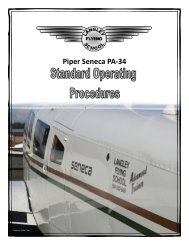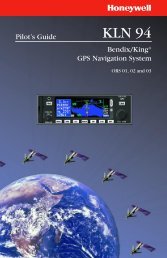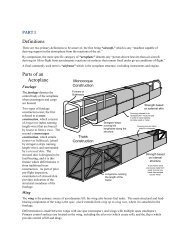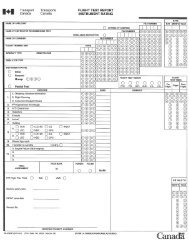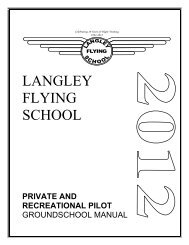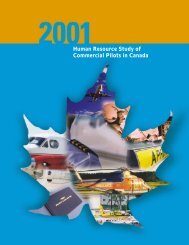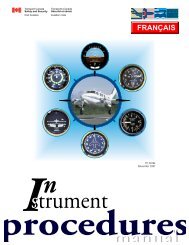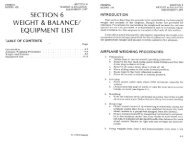LANGLEY FLYING SCHOOL Flight Training Handbook
LANGLEY FLYING SCHOOL Flight Training Handbook
LANGLEY FLYING SCHOOL Flight Training Handbook
Create successful ePaper yourself
Turn your PDF publications into a flip-book with our unique Google optimized e-Paper software.
<strong>Flight</strong> <strong>Training</strong> <strong>Handbook</strong> Page 46<br />
Langley Flying School, Inc.<br />
and separation. 49<br />
Repetitive Circuits<br />
When flying repetitive circuits, the pilot should advise the tower of his position each time he passes mid-field in the<br />
downwind leg. When advising the tower of his position, he should also provide his landing intentions. For<br />
example:<br />
Pilot:<br />
Controller:<br />
“ABC Downwind Left, Runway one nine, touch-and-go.”<br />
“ABC Cleared touch-and-go, Runway one nine.”<br />
Pilot:<br />
Controller:<br />
“ABC Downwind Left, Runway one nine, full stop.”<br />
“ABC Number 3 behind a Cherokee on short final, and a Cessna on left base.”<br />
In the latter instance, again a landing clearance would be expected when you reach your final approach.<br />
Airports with Two Tower Controllers<br />
At some airports there may be two tower frequencies, an “outer” frequency, and an “inner frequency”—e.g.,<br />
Victoria Airport and Abbotsford Airport. Inbound for landing, you first contact the outer frequency controller, and<br />
he will subsequently advise you when to switch to the inner controller. It is always a good idea to have your radios<br />
adjusted so that you switch frequencies with the flick of a switch. The communication will go something like this:<br />
Outer Tower<br />
Controller:<br />
Pilot:<br />
“ABC, Cleared Left Base Runway zero seven. Contact tower now on one eight<br />
decimal two.”<br />
“ABC, Roger.”<br />
After you switch, check in with the controller.<br />
Pilot:<br />
Inner Tower<br />
Controller:<br />
Pilot:<br />
“Tower, ABC with you on a Left Base zero seven.<br />
“ABC Roger, Number 2 behind a Cessna on short final.”<br />
“ABC.”<br />
If you are asked to change frequency and have not been provided a circuit clearance, then report your current<br />
altitude: 50<br />
Pilot:<br />
Inner Tower<br />
Controller:<br />
Pilot:<br />
“Tower, ABC with you, level two thousand.”<br />
“ABC Roger, Cleared Left Base, zero seven.”<br />
“Left Base zero seven, ABC.”<br />
You don’t have to sound like an Air Canada pilot just yet, but the Examiner will expect you to handle radio<br />
transmissions and receptions effectively during your flight test. At first it will sound absolutely confusing, but very<br />
quickly you will be able to decipher patterns and then radio work will make sense to you. Radio work at<br />
uncontrolled airports is somewhat different and this is reviewed on P. Error! Bookmark not defined..<br />
49 This is perhaps one of the most dangerous scenarios—all the players think you have a target in sight when in fact you don’t. Don’t hesitate to<br />
say you have lost your target. As well, it is not uncommon for a pilot to lose contact with a target that has been assigned by a controller and<br />
reported in sight by the pilot. In such a case the pilot must immediately advise the controller that visual contact has been lost—“Tower, Alpha<br />
Bravo Charlie has lost the target.” “ Alpha Bravo Charlie, Tower, aircraft (target) no longer a factor, turn base at your discretion.”<br />
50 The outer and inner controllers are sitting next to each other in the tower cab (control tower) and are continuously exchanging information—<br />
really quite interesting how they work.<br />
2012 David L. Parry



